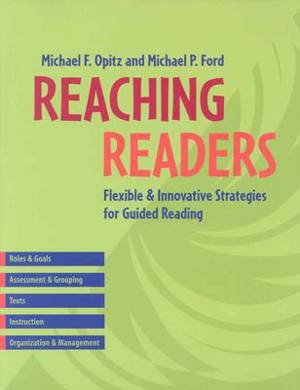
- Afhalen na 1 uur in een winkel met voorraad
- Gratis thuislevering in België vanaf € 30
- Ruim aanbod met 7 miljoen producten
- Afhalen na 1 uur in een winkel met voorraad
- Gratis thuislevering in België vanaf € 30
- Ruim aanbod met 7 miljoen producten
Zoeken
Reaching Readers
Flexible and Innovative Strategies for Guided Reading
Michael F Opitz, Michael P Ford
Paperback | Engels
€ 53,95
+ 107 punten
Omschrijving
The breakout success of guided reading comes as no surprise to most teachers. But is there only one way to do guided reading? Must teachers follow a defined set of guidelines? Michael Opitz and Michael Ford's response is an emphatic "No." With Reaching Readers, they offer a second-generation model of guided readingone that urges teachers to expand their vision and presents alternative practices.
Reaching Readers originates from the idea that there are at least five considerations that need to be thought through for meaningful guided reading to occur:
- Roles and Goals There are many different guided reading experiences, each one calling for different ways to group children and structure what happens. Opitz and Ford help you think through your roles and goals to obtain a broader perspective.
- Assessment and Grouping Good instruction begins with assessing, which leads to grouping decisions. Reaching Readers addresses your concerns about size, number, and group members, including how to use the results of assessment strategies and form groups.
- Texts There are many different types of texts and several ways to match texts to readers. Readers will find here suggestions for using each type of text as well as sample titles.
- Instruction It's essential that each guided reading lesson be strategically planned. Opitz and Ford visit nine different classrooms that show purposeful guided reading experiences in action to help you develop your own instruction.
- Organization and Management One adult with several children requires some kind of organization and management plan. The book presents ideas for keeping children meaningfully engaged, freeing you to interact with small guided reading groups with minimal interruptions.
Specificaties
Betrokkenen
- Auteur(s):
- Uitgeverij:
Inhoud
- Aantal bladzijden:
- 192
- Taal:
- Engels
Eigenschappen
- Productcode (EAN):
- 9780325003580
- Verschijningsdatum:
- 14/09/2001
- Uitvoering:
- Paperback
- Formaat:
- Trade paperback (VS)
- Afmetingen:
- 215 mm x 284 mm
- Gewicht:
- 449 g

Alleen bij Standaard Boekhandel
+ 107 punten op je klantenkaart van Standaard Boekhandel
Beoordelingen
We publiceren alleen reviews die voldoen aan de voorwaarden voor reviews. Bekijk onze voorwaarden voor reviews.








